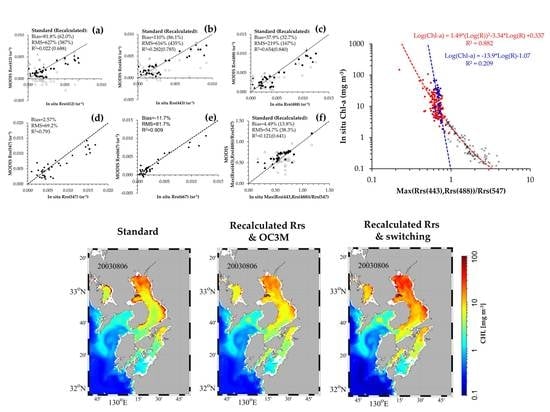Improved MODIS-Aqua Chlorophyll-a Retrievals in the Turbid Semi-Enclosed Ariake Bay, Japan
Abstract
1. Introduction
2. Materials and Methods
2.1. In Situ Data
2.1.1. Measurement of Chl-a
2.1.2. Remote Sensing Reflectance (Rrs)
2.1.3. Absorption by CDOM, Phytoplankton, and NPP
2.1.4. Measurements of Total Suspended Matter
2.2. Satellite Data
2.3. Recalculation of Rrs
2.4. Statistical Analysis
3. Results
3.1. Evaluation of Standard Satellite Chl-a
3.2. Validation and Recalculation of Rrs
3.3. Validation and Improvement of In-Water Algorithm
3.4. Evaluation of the Improved MODIS Chl-a
4. Discussion
4.1. Improvement of Chl-a
4.2. Atmospheric Correction
4.3. In-Water Algorithm
5. Conclusions
Supplementary Materials
Author Contributions
Funding
Acknowledgments
Conflicts of Interest
References
- Shin, M.; Lee, H.J.; Kim, M.S.; Park, N.B.; Lee, C. Control of the red tide dinoflagellate Cochlodinium polykrikoides by ozone in seawater. Water Res. 2017, 109, 237–244. [Google Scholar] [CrossRef] [PubMed]
- Tsutsumi, H. Critical events in the Ariake Bay ecosystem: Clam population collapse, red tides, and hypoxic bottom water. Plankton Benthos Res. 2006, 1, 3–25. [Google Scholar] [CrossRef]
- Suzuki, K.W.; Nakayama, K.; Tanaka, M. Horizontal distribution and population dynamics of the dominant mysid Hyperacanthomysis longirostris along a temperate macrotidal estuary (Chikugo River estuary, Japan). Estuar. Coast. Shelf Sci. 2009, 83, 516–528. [Google Scholar] [CrossRef]
- Ishizaka, J.; Kitaura, Y.; Touke, Y.; Sasaki, H.; Tanaka, A.; Murakami, H.; Suzuki, T.; Matsuoka, K.; Nakata, H. Satellite detection of red tide in Ariake Sound, 1998–2001. J. Oceanogr. 2006, 62, 37–45. [Google Scholar] [CrossRef]
- Gordon, H.R. Atmospheric correction of ocean color imagery in the Earth Observing System era. J. Geophys. Res. 1997, 102, 17081–17106. [Google Scholar] [CrossRef]
- Siegel, D.A.; Wang, M.; Maritorena, S.; Robinson, W. Atmospheric correction of satellite ocean-color imagery: The black pixel assumption. Appl. Opt. 2000, 39, 3582–3591. [Google Scholar] [CrossRef] [PubMed]
- Goyens, C.; Jamet, C.; Schroeder, T. Evaluation of four atmospheric correction algorithms for MODIS images over contrasted coastal waters. Remote Sens. Environ. 2013, 131, 63–75. [Google Scholar] [CrossRef]
- Shehhi, M.R.; Gherboudj, I.; Zhao, J.; Ghedira, H. Improved atmospheric correction and chlorophyll-a remote sensing models for turbid waters in a dusty environment. ISPRS J. Photogramm. Remote Sens. 2017, 133, 46–60. [Google Scholar] [CrossRef]
- Wang, M.; Shi, W. The NIR-SWIR combined atmospheric correction approach for MODIS ocean color data processing. Opt. Express 2007, 15, 15722–15733. [Google Scholar] [CrossRef] [PubMed]
- Wang, M.; Son, S.; Shi, W. Evaluation of MODIS SWIR and NIR-SWIR Atmospheric correction algorithm using SeaBASS data. Remote Sens. Environ. 2009, 113, 635–644. [Google Scholar] [CrossRef]
- Schroeder, T.; Behnert, I.; Schaale, M.; Fischer, J.; Doerffer, R. Atmospheric correction algorithm for MERIS above case-2 waters. Int. J. Remote Sens. 2007, 28, 1469–1486. [Google Scholar] [CrossRef]
- Brajard, J.; Santer, R.; Crépon, M.; Thiria, S. Atmospheric correction of MERIS data for case-2 waters using a neuro-variational inversion. Remote Sens. Environ. 2012, 126, 51–61. [Google Scholar] [CrossRef]
- Loisel, H.; Vantrepotte, V.; Jamet, C.; Dinh, D.N. Challenges and new advances in ocean color remote sensing of coastal waters. In Topics in Oceanography; Zambianchi, E., Ed.; IntechOpen, 2013; Available online: https://www.intechopen.com/books/topics-in-oceanography/challenges-and-new-advances-in-ocean-color-remote-sensing-of-coastal-waters (accessed on 21 August 2018). [CrossRef]
- Hayashi, M.; Ishizaka, J.; Kobayashi, H.; Toratani, M.; Nakamura, T.; Nakashima, Y.; Yamada, S. Evaluation and Improvement of MODIS and SeaWiFS-derived Chlorophyll a Concentration in Ise-Mikawa Bay. J. Remote Sens. Soc. Jpn. 2015, 35, 245–259, (In Japanese with English Abstract). [Google Scholar]
- Darecki, M.; Stramski, D. An evaluation of MODIS and SeaWiFS bio-optical algorithms in the Baltic Sea. Remote Sens. Environ. 2004, 89, 326–350. [Google Scholar] [CrossRef]
- Dall’Olmo, G.; Gitelson, A.A.; Rundquist, D.C.; Leavitt, B.; Barrow, T.; Holz, J.C. Assessing the potential of SeaWiFS and MODIS for estimating chlorophyll concentration in turbid productive waters using red and near-infrared bands. Remote Sens. Environ. 2005, 96, 176–187. [Google Scholar] [CrossRef]
- Gitelson, A.A.; Schalles, J.F.; Hladik, C.M. Remote chlorophyll-a retrieval in turbid, productive estuaries: Chesapeake Bay case study. Remote Sens. Environ. 2007, 109, 464–472. [Google Scholar] [CrossRef]
- Le, C.; Hu, C.; Cannizzaro, J.; Duan, H. Long-term distribution patterns of remotely sensed water quality parameters in Chesapeake Bay. Estuar. Coast. Shelf Sci. 2013, 128, 93–103. [Google Scholar] [CrossRef]
- Carder, K.L.; Chen, F.R.; Cannizzaro, J.P.; Campbell, J.W.; Mitchell, B.G. Performance of the MODIS semi-analytical ocean color algorithm for chlorophyll-a. Adv. Space Res. 2004, 33, 1152–1159. [Google Scholar] [CrossRef]
- Siswanto, E.; Tang, J.; Yamaguchi, H.; Ahn, Y.H.; Ishizaka, J.; Yoo, S.; Kim, S.W.; Kiyomoto, Y.; Yamada, K.; Chiang, C.; et al. Empirical ocean-color algorithms to retrieve chlorophyll-a, total suspended matter, and colored dissolved organic matter absorption coefficient in the Yellow and East China Seas. J. Oceanogr. 2011, 67, 627–650. [Google Scholar] [CrossRef]
- Tassan, S. Local algorithms using SeaWiFS data for the retrieval of phytoplankton, pigments, suspended sediment, and yellow substance in coastal waters. Appl. Opt. 1994, 33, 2369–2378. [Google Scholar] [CrossRef] [PubMed]
- Yamaguchi, H.; Ishizaka, J.; Siswanto, E.; Son, Y.B.; Yoo, S.; Kiyomoto, Y. Seasonal and spring interannual variations in satellite observed chlorophyll-a in the Yellow and East China Seas: New datasets with reduced interference from high concentration of resuspended sediment. Cont. Shelf Res. 2013, 59, 1–9. [Google Scholar] [CrossRef]
- Suzuki, R.; Ishimaru, T. An improved method for the determination of phytoplankton chlorophyll using N,N-dimethylformamide. J. Oceanogr. Soc. Jpn. 1990, 46, 190–194. [Google Scholar] [CrossRef]
- Welschmeyer, N. Fluorometric analysis of chlorophyll a in the presence of chlorophyll b and pheopigments. Limnol. Oceanogr. 1994, 38, 1985–1992. [Google Scholar] [CrossRef]
- Holm-Hansen, O.; Lorenzen, C.J.; Holmes, R.W.; Strickland, J.D.H. Fluorometric determination of chlorophyll. J. Cons. Perm. Int. Explor. Mer. 1965, 30, 3–15. [Google Scholar] [CrossRef]
- Tanaka, A.; Sasaki, H.; Ishizaka, J. Alternative measuring method for water leaving radiance using a radiance sensor with a domed cover. Opt. Express 2006, 14, 3099–3105. [Google Scholar] [CrossRef] [PubMed]
- Kobayashi, H.; Ishizaka, J.; Jintasaerance, P.; Gunbua, V.; Fukasawa, T. Water-Leaving Radiance Measured Using with Covered Radiometers in Highly Turbid Waters. In Proceedings of the Ocean Optics XX, Anchorage, AK, USA, 27 September–1 October 2010. [Google Scholar]
- Sasaki, H.; Tanaka, A.; Iwataki, M.; Touke, Y.; Siswanto, E.; Tang, C.K.; Ishizaka, J. Optical Properties of Red Tide in Isahaya Bay, Southwestern Japan: Influence of chlorophyll a concentration. J. Oceanogr. 2008, 64, 511–523. [Google Scholar] [CrossRef]
- Mitchell, B.G.; Kahru, M.; Wieland, J.; Stramska, M. Determination of spectral absorption coefficients of particles, dissolved material and phytoplankton for discrete water samples. In Ocean Optics Protocols for Satellite Ocean Color Sensor Validation; Mueller, J.L., Fargion, G.S., Eds.; Revision 3; NASA Technical Memorandum: Cleveland, OH, USA, 2002; Volume 2, pp. 231–257. [Google Scholar]
- Kishino, M.; Takahashi, M.; Okami, N.; Ichimura, S. Estimation of the spectral absorption coefficients of phytoplankton in a thermally stratified sea. Bull. Mar. Sci. 1985, 37, 634–642. [Google Scholar]
- Cleveland, J.S.; Weidemann, A.D. Quantifying absorption by aquatic particles: A multiple scattering correction for glass-fiber filters. Limnol. Oceanogr. 1993, 38, 1321–1327. [Google Scholar] [CrossRef]
- Kanayama, S.; Yabuki, S.; Yanagisawa, F.; Motoyama, R. The chemical and strontium isotope composition of atmospheric aerosols over Japan: The contribution of long range-transported Asian dust (Kosa). Atmos. Environ. 2002, 36, 5159–5175. [Google Scholar] [CrossRef]
- O’Reilly, J.E.; Maritorena, S.; Siegel, D.A.; O’Brien, M.C.; Toole, D.; Mitchell, B.G.; Kahru, M.; Chavez, F.P.; Strutton, P.; Cota, G.F.; et al. Ocean color chlorophyll a algorithms for SeaWiFS, OC2, and OC4: Version 4. In SeaWiFS Postlaunch Calibration and Validation Analyses: Part 3; Hooker, S.B., Firestone, E.R., Eds.; NASA Technical Memorandum: Cleveland, OH, USA, 2000; Volume 11, pp. 9–23. [Google Scholar]
- Morel, A.; Prieur, L. Analysis of variations in ocean color. Limnol. Oceanogr. 1977, 22, 709–722. [Google Scholar] [CrossRef]
- Prieur, L.; Sathyendranath, S. An optical classification of coastal and oceanic waters based on the specific absorption curves of phytoplankton pigments, dissolved organic matter, and other particulate materials. Limnol. Oceanogr. 1981, 26, 671–689. [Google Scholar] [CrossRef]
- Robinson, W.D.; Franz, B.A.; Patt, F.S.; Bailey, S.W.; Werdell, P.J. Masks and flags updates. In SeaWiFS Postlaunch Technical Report Series; NASA Technical Memorandum: Cleveland, OH, USA, 2003; pp. 34–40. [Google Scholar]
- McClain, C.R.; Feldman, G.C.; Hooker, S.B.; Bontempi, P. Satellite data for ocean biology, biogeochemistry, and climate research. EOS 2006, 87, 337–343. [Google Scholar]
- Moore, T.S.; Campbell, J.W.; Dowell, M.D. A class-based approach to characterizing and mapping the uncertainty of the MODIS ocean chlorophyll product. Remote Sens. Environ. 2009, 113, 2424–2430. [Google Scholar] [CrossRef]
- Wang, M.; Shi, W. Estimation of ocean contribution at the MODIS near infrared wavelengths along the east coast of the U.S.: Two case studies. Geophys. Res. Lett. 2005, 32, L13606. [Google Scholar] [CrossRef]
- Li, L.-P.; Fukushima, H.; Frouin, R.; Mitchell, B.G.; He, M.-X.; Uno, I.; Takamura, T.; Ohta, S. Influence of submicron absorptive aerosol on SeaWiFS-derived marine reflectance during ACE-Asia. J. Geophys. Res. 2003, 108. [Google Scholar] [CrossRef]
- Toratani, M.; Fukushima, H.; Murakami, H.; Tanaka, A. Atmospheric correction scheme for GLI with absorptive aerosol correction. J. Oceanogr. 2007, 63, 525–532. [Google Scholar] [CrossRef]
- Moreno, T.; Kojima, T.; Amato, F.; Lucarelli, F.; de la Rosa, J.; Calzolai, G.; Nava, S.; Chiari, M.; Alastuey, A.; Querol, X.; et al. Daily and hourly chemical impact of springtime transboundary aerosols on Japanese air quality. Atmos. Chem. Phys. 2013, 13, 1411–1424. [Google Scholar] [CrossRef]
- Wang, M.; Gordon, H.R. A simple, moderately accurate, atmospheric correction algorithm for SeaWiFS. Remote Sens. Environ. 1994, 50, 231–239. [Google Scholar] [CrossRef]
- Adler-Golden, S.M.; Matthew, M.W.; Bernstein, L.S.; Levine, R.Y.; Berk, A.; Richtsmeier, S.C.; Acharya, P.K.; Anderson, G.P.; Felde, G.; Gardner, J.; et al. Atmospheric Correction for Short-Wave Spectral Imagery Based on MODTRAN4. In SPIE Proceedings, Imaging Spectrom; International Society for Optics and Photonics: Denver, CO, USA, 1999; Volume 3753, pp. 61–69. [Google Scholar]
- Lee, S.; Meister, G. MODIS Aqua Optical Throughput Degradation Impact on Relative Spectral Response and Calibration of Ocean Color Products. IEEE Trans. Geosci. Remote Sens. 2017, 55, 5214–5219. [Google Scholar] [CrossRef]
- Morel, A. Optical modeling of the upper ocean in relation to its biogenous matter content (Case I Waters). J. Geophys. Res. 1988, 93, 10749–10768. [Google Scholar] [CrossRef]
- Woźniak, S.B.; Stramski, D. Modeling the optical properties of mineral particles suspended in seawater and their influence on ocean reflectance and chlorophyll estimation from remote sensing algorithms. Appl. Opt. 2004, 43, 3489–3503. [Google Scholar] [CrossRef] [PubMed]
- Dogliotti, A.I.; Schloss, I.R.; Almandoz, G.O.; Gagliardini, D.A. Evaluation of SeaWiFS and MODIS chlorophyll-a products in the Argentinean Patagonian Continental Shelf (38° S–55° S). Int. J. Remote Sens. 2009, 1, 251–273. [Google Scholar] [CrossRef]
- Siswanto, E.; Ishizaka, J.; Tripathy, S.C.; Miyamura, K. Detection of harmful algal blooms of Karenia mikimotoi using MODIS measurements: A case study of Seto-Inland Sea, Japan. Remote Sens. Environ. 2013, 129, 185–196. [Google Scholar] [CrossRef]
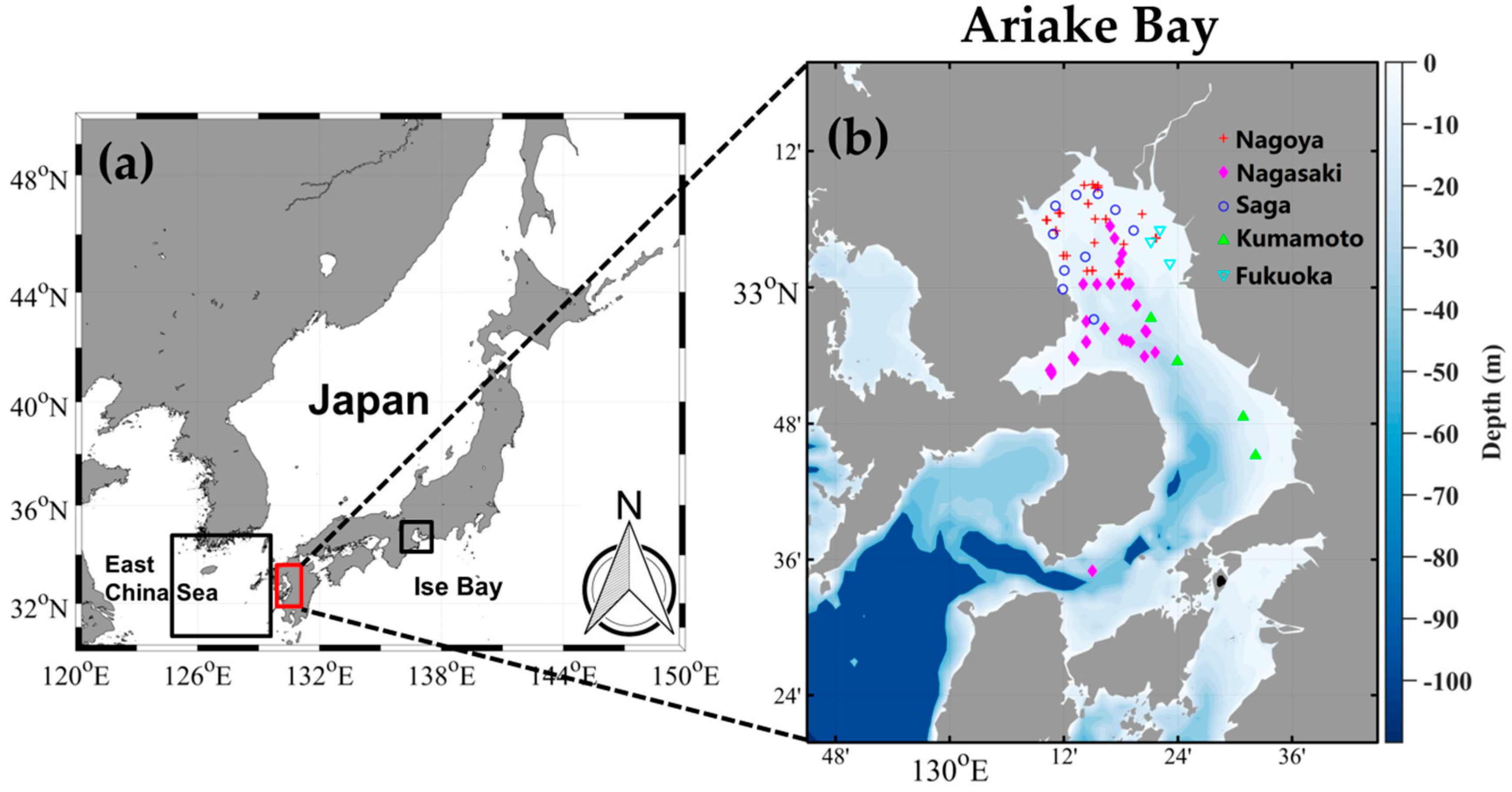
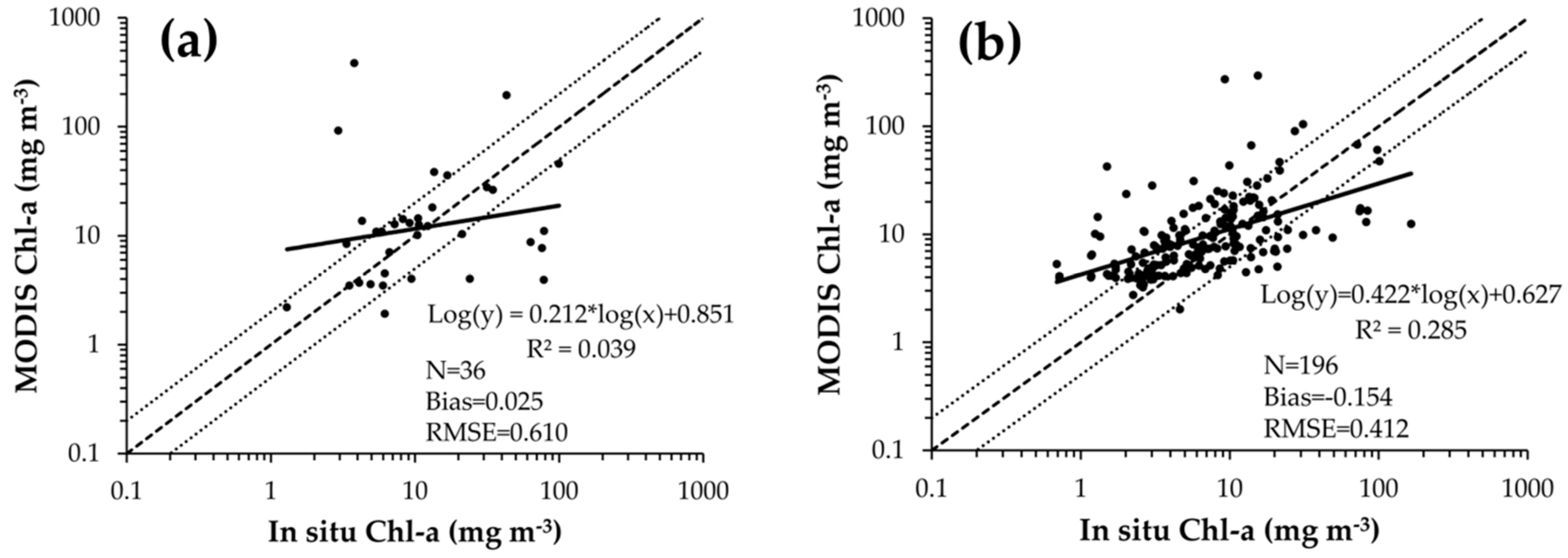
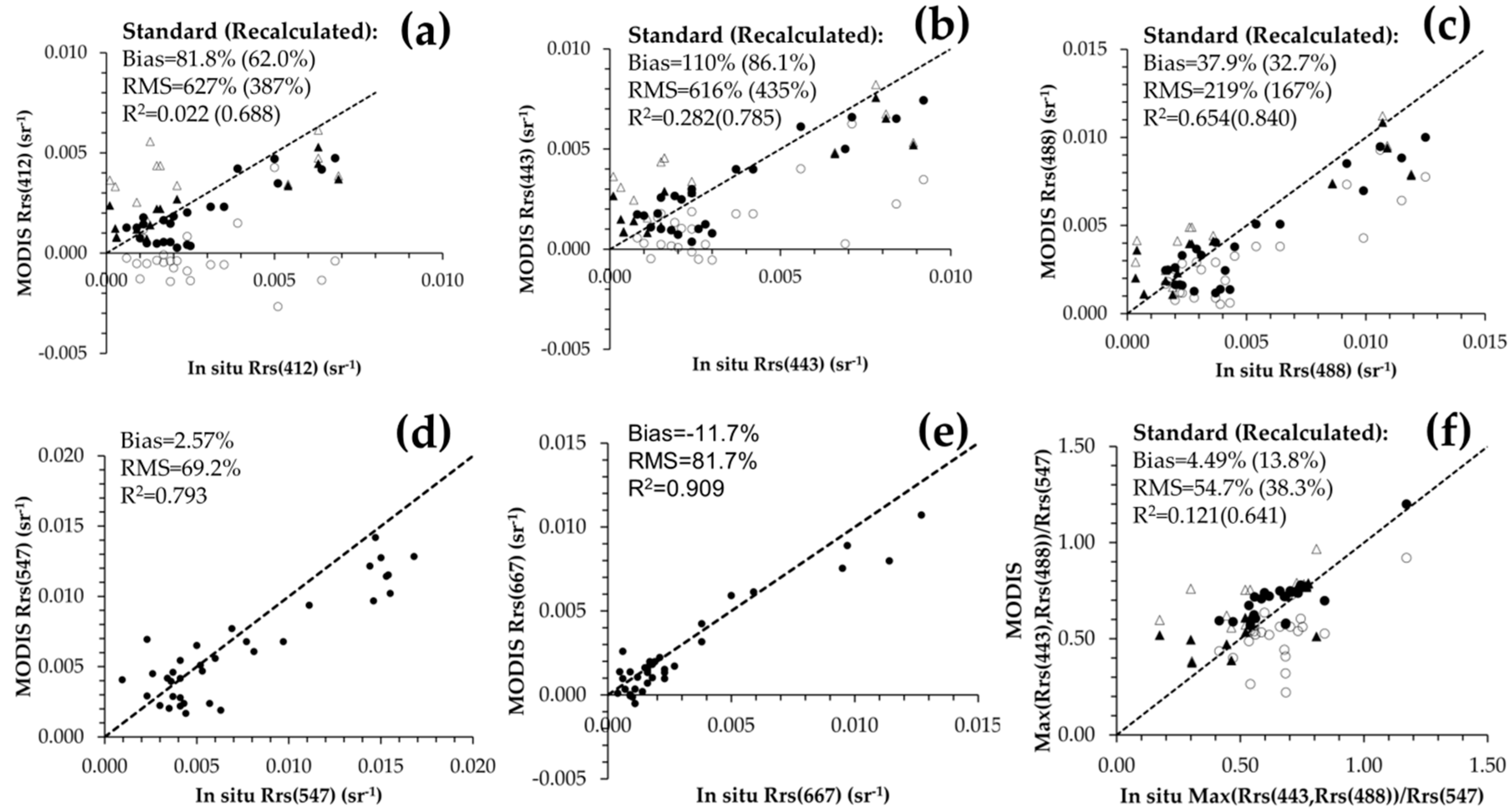
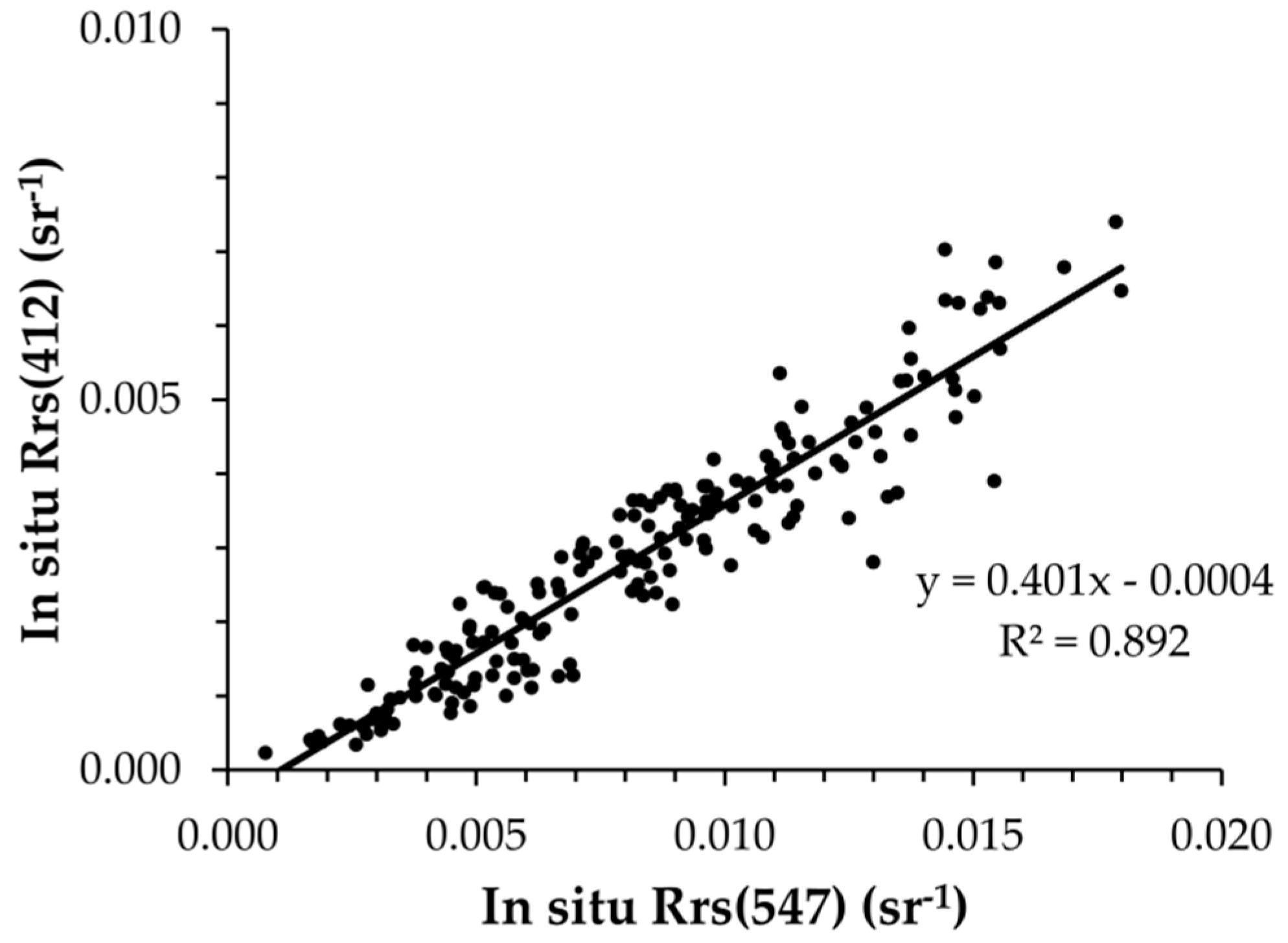
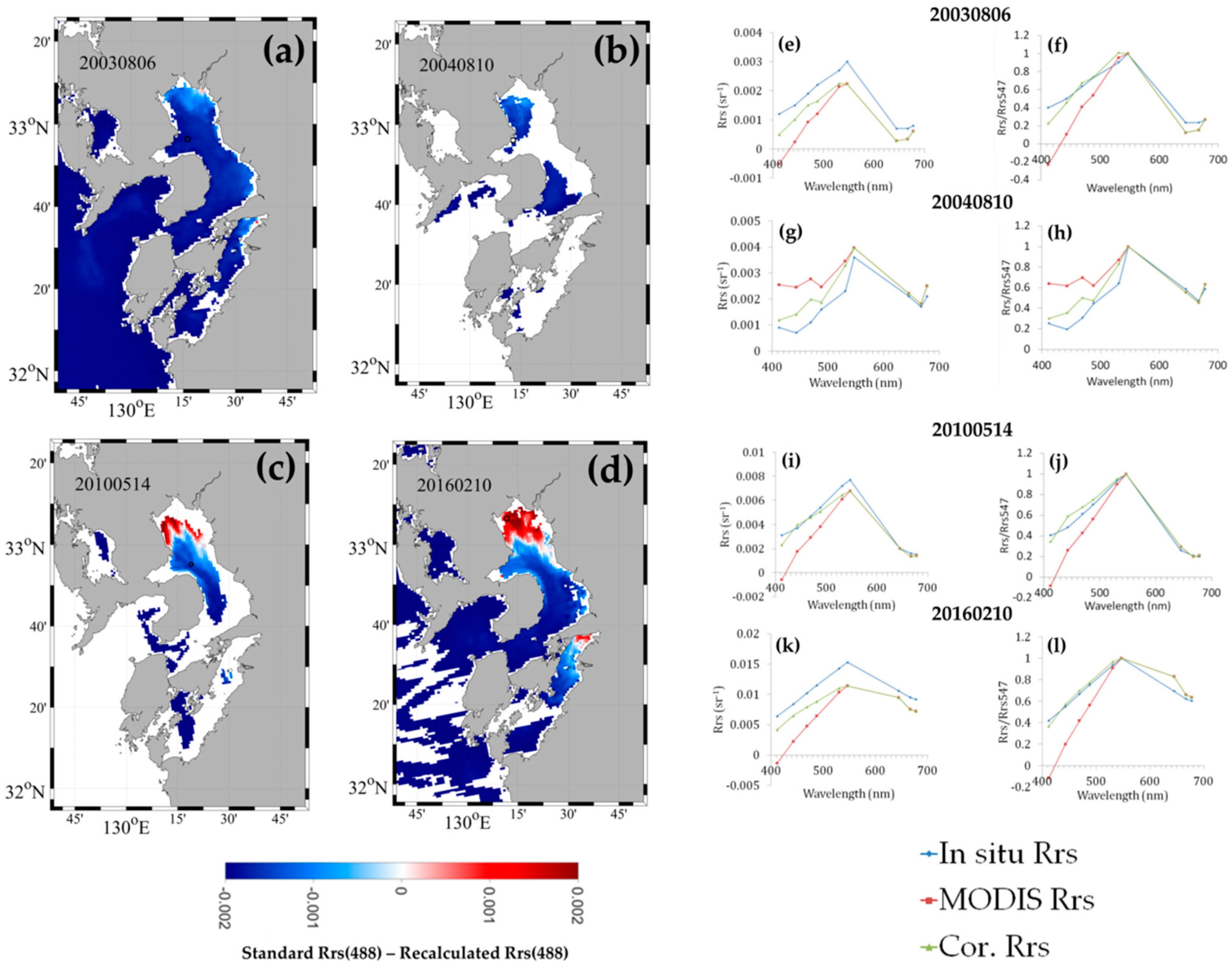
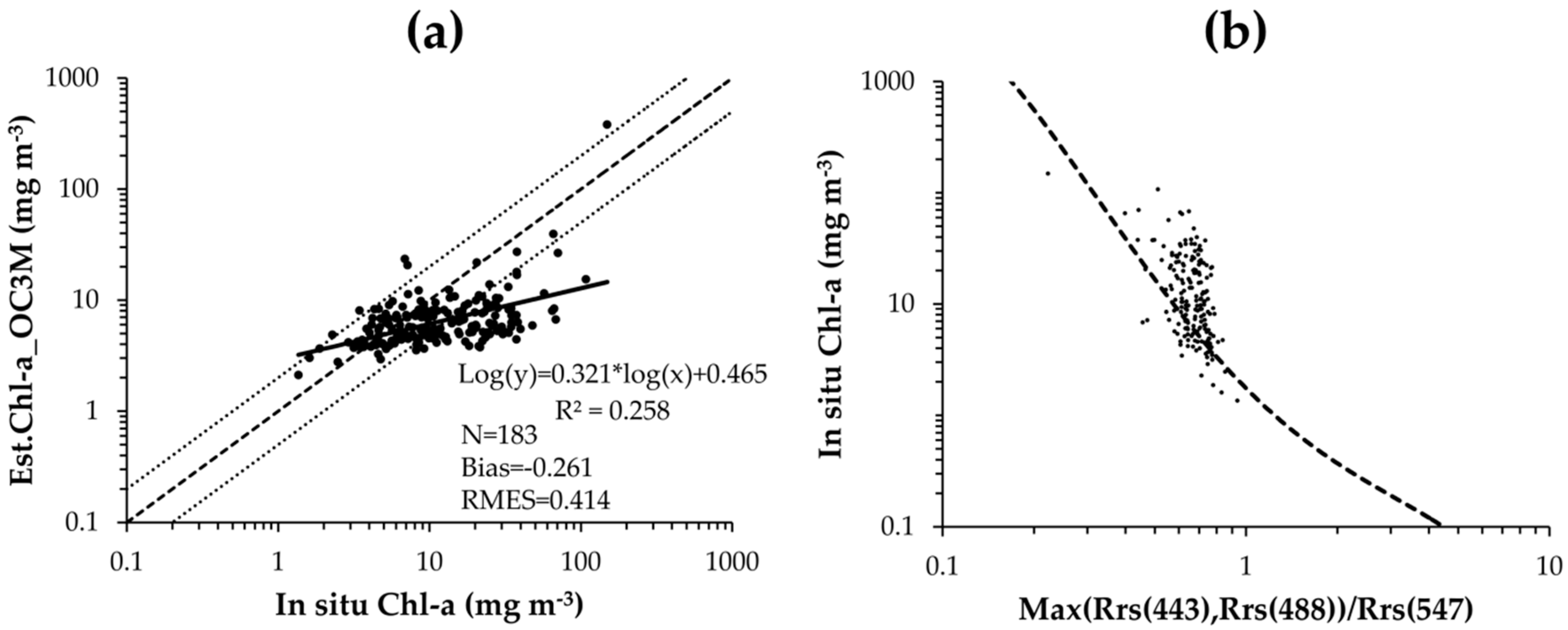
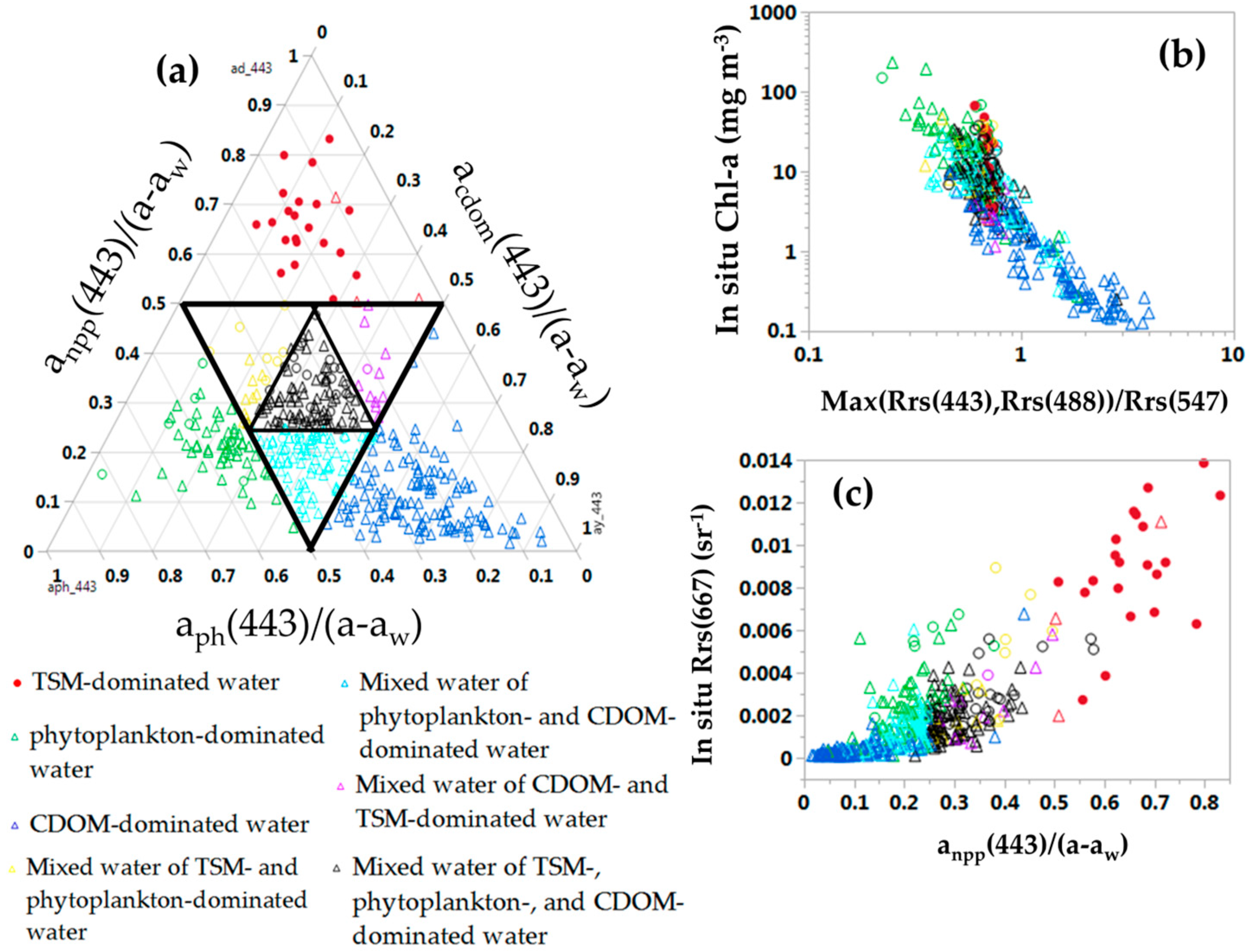
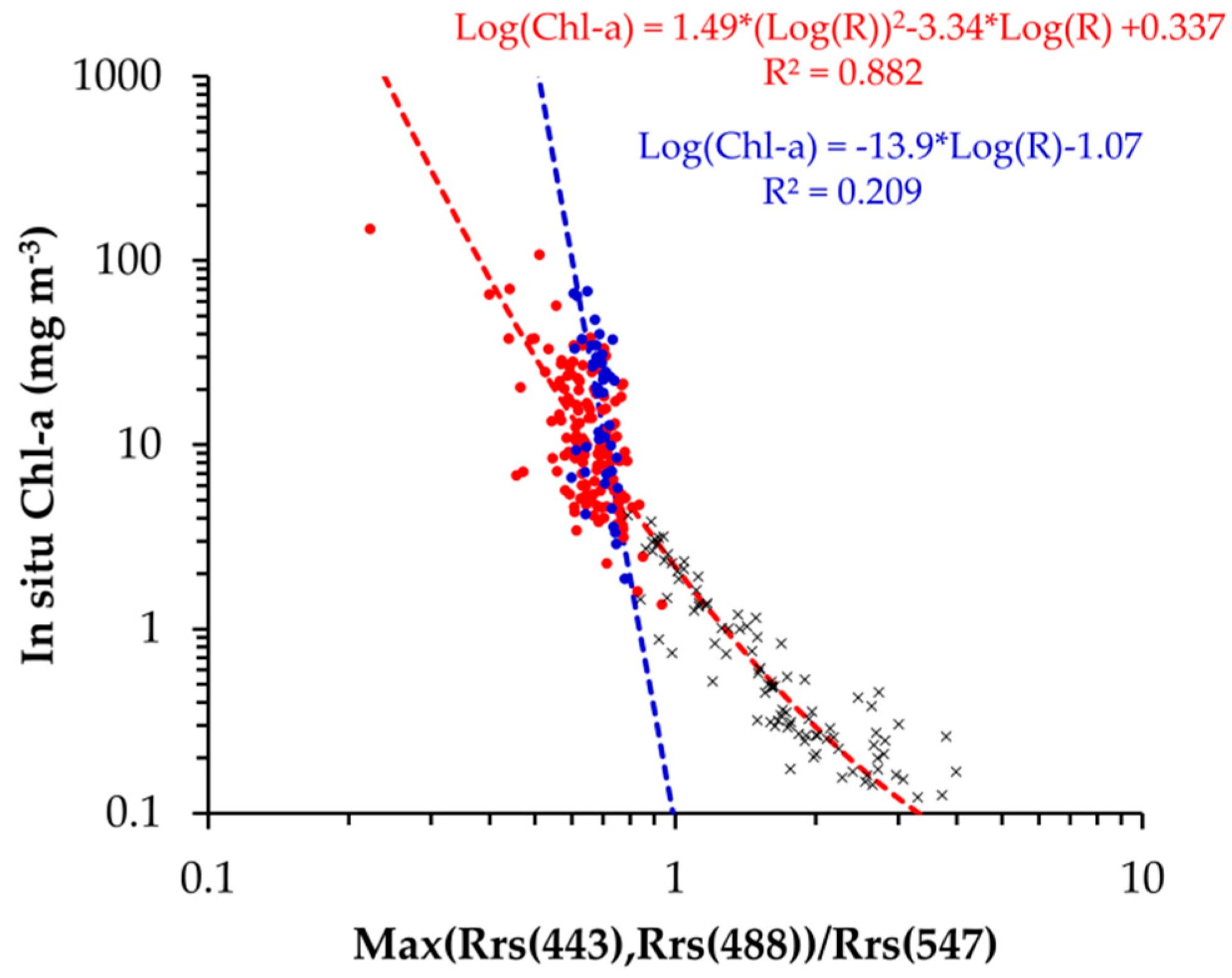
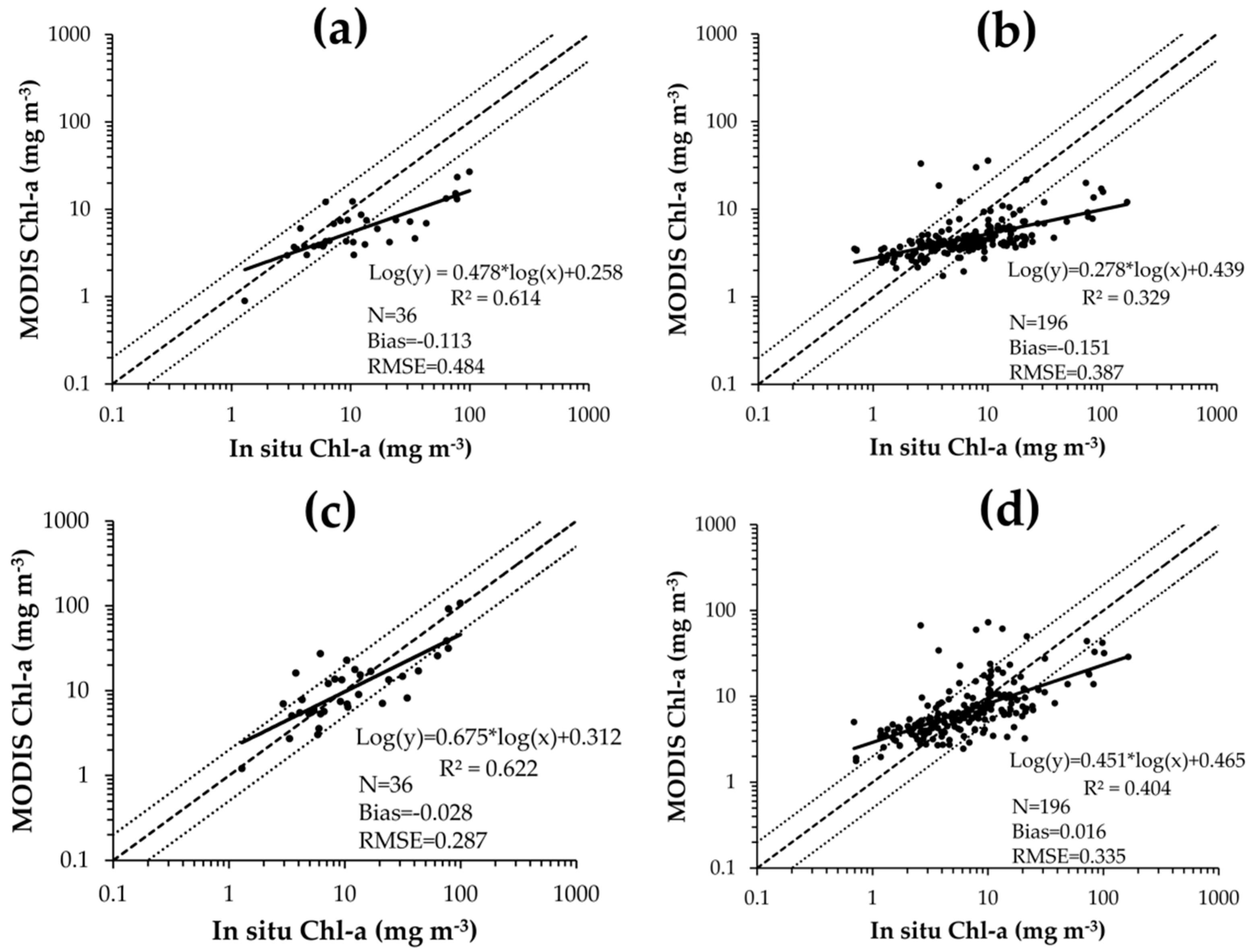
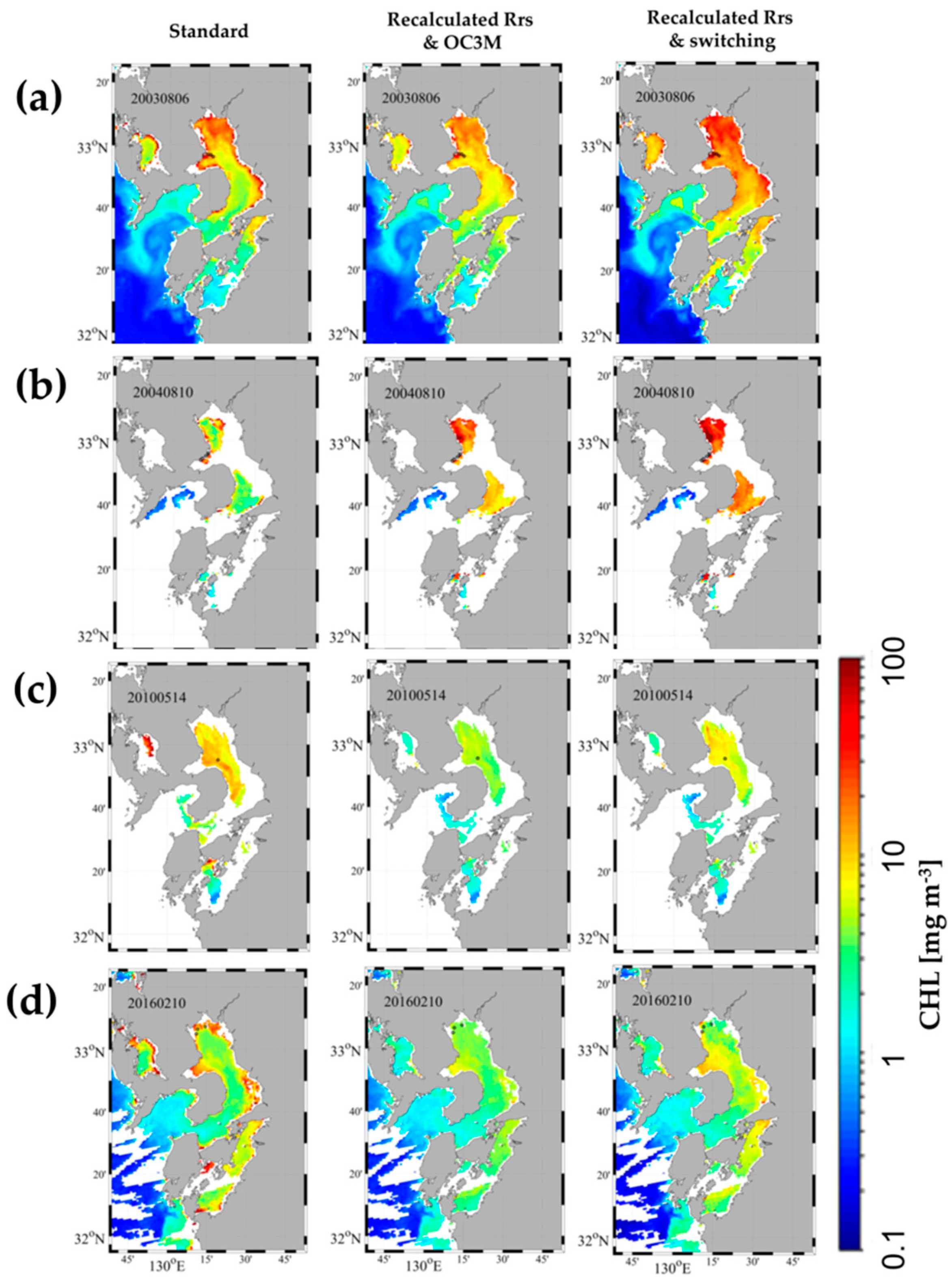
| Location | Dataset | Time Period | In Situ Data Number | Match-Up Data 1 Number | Purposes | ||||||
|---|---|---|---|---|---|---|---|---|---|---|---|
| 1 | 2 | 3 | 4 | 5 | 6 | ||||||
| Ariake Bay | Nagoya University | 2015–2017 | 87 | 6 | ✓ | ✓ | ✓ | ✓ | ✓ | ✓ | |
| Nagasaki University | 2001–2010 | 341 | 30 | ✓ | ✓ | ✓ | ✓ | ✓ | ✓ | ||
| Fisheries Research Institute | Saga Ariake Fisheries Promotion Center | 2011–2015 | 2256 | 177 | ✓ | ✓ | |||||
| Fukuoka Fisheries and Marine Technology Research Center | 2011–2014 | 465 | 6 | ✓ | ✓ | ||||||
| Kumamoto Prefectural Fisheries Research Center | 2011–2015 | 481 | 13 | ✓ | ✓ | ||||||
| East China Sea | ECS | Nagoya University | 2009–2016 | 151 | - | ✓ | ✓ | ||||
| Ise and Mikawa Bay | Ise Bay | Nagoya University | 2011–2015 | 249 | - | ✓ | |||||
| Purposes | |||||||||||
| 1. Evaluate the standard Chl-a product of NASA OC3M. 2. Evaluate the standard Rrs product of MODIS-Aqua. 3. Evaluate the OC3M algorithm using in situ measurements. 4. Classify water properties. 5. Develop a new switching algorithm. 6. Validate the Rrs recalculation method and the switching algorithm. | |||||||||||
| Parameters | Mean | Standard Deviation | Coefficient Variation | Min | Max |
|---|---|---|---|---|---|
| Chl-a | 17.1 | 18.2 | 1.06 | 1.36 | 149 |
| TSM | 10.8 | 9.52 | 0.885 | 0.333 | 62.5 |
| CDOM | 0.384 | 0.173 | 0.451 | 0.142 | 0.834 |
| aph/(aph + anpp + ay) at 443 nm | 0.360 | 0.163 | 0.453 | 0.050 | 0.818 |
| anpp/(aph + anpp + ay) at 443 nm | 0.375 | 0.172 | 0.458 | 0.017 | 0.831 |
| ay/(aph + anpp + ay) at 443 nm | 0.265 | 0.119 | 0.450 | 0.027 | 0.895 |
| Ariake Data Whole | Non-Turbid Water | Turbid Water | ||||
|---|---|---|---|---|---|---|
| OC3M | Switching Algorithm | OC3M | Switching Algorithm | OC3M | Switching Algorithm | |
| Data number | 183 | 183 | 137 | 137 | 46 | 46 |
| Slope | 0.443 | 0.518 | 0.446 | 0.522 | 0.108 | 0.457 |
| r2 | 0.372 | 0.331 | 0.375 | 0.373 | 0.204 | 0.209 |
| Bias | −0.261 | −0.001 | −0.199 | 0.001 | −0.444 | 2 × 10−7 |
| RMSE | 0.414 | 0.326 | 0.348 | 0.296 | 0.568 | 0.402 |
| Absolute RE | 29.9% | 28.0% | 27.0% | 27.2% | 38.5% | 30.3% |
© 2018 by the authors. Licensee MDPI, Basel, Switzerland. This article is an open access article distributed under the terms and conditions of the Creative Commons Attribution (CC BY) license (http://creativecommons.org/licenses/by/4.0/).
Share and Cite
Yang, M.M.; Ishizaka, J.; Goes, J.I.; Gomes, H.D.R.; Maúre, E.D.R.; Hayashi, M.; Katano, T.; Fujii, N.; Saitoh, K.; Mine, T.; et al. Improved MODIS-Aqua Chlorophyll-a Retrievals in the Turbid Semi-Enclosed Ariake Bay, Japan. Remote Sens. 2018, 10, 1335. https://doi.org/10.3390/rs10091335
Yang MM, Ishizaka J, Goes JI, Gomes HDR, Maúre EDR, Hayashi M, Katano T, Fujii N, Saitoh K, Mine T, et al. Improved MODIS-Aqua Chlorophyll-a Retrievals in the Turbid Semi-Enclosed Ariake Bay, Japan. Remote Sensing. 2018; 10(9):1335. https://doi.org/10.3390/rs10091335
Chicago/Turabian StyleYang, Meng Meng, Joji Ishizaka, Joaquim I. Goes, Helga Do R. Gomes, Elígio De Raús Maúre, Masataka Hayashi, Toshiya Katano, Naoki Fujii, Katsuya Saitoh, Takayuki Mine, and et al. 2018. "Improved MODIS-Aqua Chlorophyll-a Retrievals in the Turbid Semi-Enclosed Ariake Bay, Japan" Remote Sensing 10, no. 9: 1335. https://doi.org/10.3390/rs10091335
APA StyleYang, M. M., Ishizaka, J., Goes, J. I., Gomes, H. D. R., Maúre, E. D. R., Hayashi, M., Katano, T., Fujii, N., Saitoh, K., Mine, T., Yamashita, H., Fujii, N., & Mizuno, A. (2018). Improved MODIS-Aqua Chlorophyll-a Retrievals in the Turbid Semi-Enclosed Ariake Bay, Japan. Remote Sensing, 10(9), 1335. https://doi.org/10.3390/rs10091335




